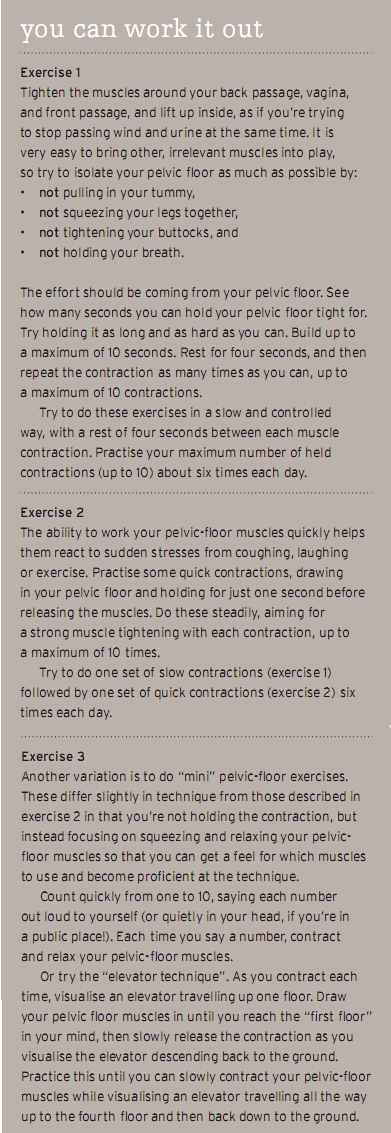Pay attention to your pelvic floor!

You've been told you should do pelvic-floor exercises, but why are they so important? And how do you know if you're doing them right? Lou James explains why pelvic-floor exercises are so crucial, especially to women who are suffering from incontinence.
There is a secret that one in three women keep. It happens to large numbers of women, but most are too embarrassed to talk about it. Incontinence - not being able to always control your waterworks - is definitely a taboo subject among today's super-busy mums.
Some people believe incontinence is part of the price women pay for being mothers. This is simply not true. Leakage may be common, but it's never normal. It is not something you should ignore or put up with. And, most importantly, incontinence is curable.
Some women stop playing sport and exercising because of a lack of control over their bladders. Others take up swimming for exercise and avoid aerobics classes, jogging, or power-walking, just to keep the secret of their leakage safe. Research shows that many women give up exercise for this reason alone, but rarely tell anyone the truth behind their decision. It is thought that stress incontinence is a barrier to physical activity for about 10% of women, and, therefore, has an overall long-term negative effect on their physical well-being.
Incontinence can be very self-limiting and demoralising without the proper support and treatment. Yet many women suffer in silence, as it remains an unmentionable predicament. Pregnancy, labour, and delivery create extra stress for your pelvic floor. Some of this extra stress occurs slowly over several months, as the growing weight of your uterus pushes down on your pelvic floor during pregnancy. Additional stress and strain occurs acutely from trauma during labour and delivery. The pelvic floor is in its "recovery phase" for about a year after giving birth.
If you had to push your baby out for a long time, gave birth to a large baby, experienced a third- or fourth-degree tear, or underwent a forceps delivery, your pelvic floor may have been over-stretched during labour and may not recover without some extra help. Even if you had a Caesarean, you don't escape from the possibility of pelvic-floor weakness.
Unfortunately, just being pregnant can overload your pelvic floor, increasing your chances of developing problems such as incontinence, either now or later on in life. Therefore, all women who go through the amazing process of having a baby need to do something to help out their pelvic floor muscles so they can bounce back to full physical health. If you just ignore it, then chances are, it won't be in great shape! A poorly toned, weak pelvic floor will not do its job properly.
Women with weak pelvic floor muscles frequently experience incontinence and this little secret is really just the beginning of what can become a downward spiral, where loss of bladder control can be the precursor to pelvic pain, low back pain, anxiety, and depression.
This sounds all very alarming, but the good news is, incontinence can be cured or greatly reduced at any age! By following a simple pelvic-floor exercise program, otherwise known as Kegel exercises, you can regain control and never again suffer its embarrassment. Research has shown that the pelvic floor responds to regular exercise. With regular exercise, it is possible for most women to reduce or completely overcome the symptoms of weak pelvic floor muscles.
Studies also show that starting your pelvic floor exercises when you are pregnant can help you to avoid problems after your baby is born, so if you are pregnant, get as much practice in now as you can.

Pelvic-floor exercises
Pelvic-floor exercises are widely promoted as the starting point for building pelvic-floor strength. Anyone can try these exercises, but be aware that if they are not done correctly, they may aggravate a problem.
The first step is to correctly identify the muscles. Empty your bladder, then sit comfortably - your thighs, buttocks and tummy muscles should be relaxed. Lift and squeeze inside as if you are trying to hold back urine or wind from your back passage. Keep these things in mind:
🌱 If you are unable to feel a definite "squeeze and lift" action of your pelvic floor, don't worry! Even people with very weak muscles can be taught these exercises.
🌱 If you feel unsure whether you have identified the correct muscles, try to stop your flow when passing urine, then restart it. Only do this to identify the correct muscles to use - this is a test, not an exercise.
🌱 If you are unable to feel a definite "squeeze and lift" action in your pelvic-floor muscles, you should seek professional advice.
🌱 Be careful not to flex the muscles in your abdomen, thighs or buttocks. To get the maximum benefit, focus on tightening only your pelvic floor muscles.
🌱 You can do pelvic-floor exercises in the comfort of your home, car, work - just about anywhere - and no one will know.

But when will I get results?
If you do pelvic-floor exercises regularly, you will see optimum results within three to six months, but you should continue them for life to fully protect your pelvic floor.
Been there, done that, and it didn't work for you? Sometimes, women do attempt to do pelvic-floor exercises and are unsuccessful in strengthening their pelvic floor and reducing their symptoms.
There are many reasons why this can occur, but often it is because they don't exercise often enough or for long enough. Women report that they don't remember, they find it hard to fit exercises into daily life, they feel uncertain about whether the exercises are working, and they're not sure whether they are doing them correctly, particularly in the early stages. Studies suggest over 50% of women don't understand how to produce an effective contraction when prompted. In an attempt to do pelvic-floor exercises, some women do the wrong action - pushing down, not pulling up.
This action increases intra-abdominal pressure (IAP) and places more pressure on the pelvic floor. Also, attempting to do all of your pelvic floor exercises lying down is useless if you only experience stress incontinence when you are upright or out exercising.
Some women may have scarring due to tearing or episiotomies from childbirth. This can lead to poor symmetry during pelvic floor contractions. Therefore, it is very important to seek professional help if these exercises don't seem to work for you. The best results will be achieved by seeking help from a physiotherapist or continence advisor, who will design an individual training programme especially suited to you.
Why should I care?
As mothers, we spend most of the day rushing around worrying about everyone else in the family, so stopping to think about your weakened pelvic-floor muscles and doing a few squeezes is not likely to be at the forefront of your mind. However, there are many good reasons why we should dedicate a few minutes a day to keeping our waterworks in good working order.
To help trigger your mind to remember about your pelvic-floor exercises, use the tap theory. Every time you switch on a tap, to wash your hands, shower, clean the dishes, brush your teeth, run your child's bath, etc, do a couple of pelvic-floor exercises!
A third of all women suffer bladder-control problems and around half of all women in nursing homes are there primarily because their incontinence is unmanageable at home. The good news is, incontinence can be cured or greatly reduced at any age. By following a simple pelvic-floor exercise programme, you can regain control and never again suffer its embarrassment.
Lou James is an experienced physiotherapist specialising in pregnant women, new mothers and clients with specific medical issues. Lou is the mother of two boys.

AS FEATURED IN ISSUE 2 OF OHbaby! MAGAZINE. CHECK OUT OTHER ARTICLES IN THIS ISSUE BELOW

















